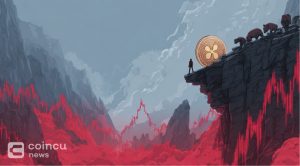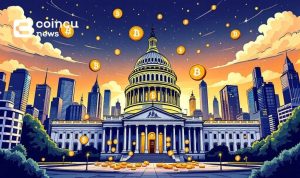Key Points:
- The Fed is in a position to make a decision between whether to continue raising interest rates or not.
- The current market is supported by the central banking system a lot, but risks still exist.
- Crypto will benefit along with other risky assets if interest rates do not rise.
The market has altered substantially in a short period of time. The Federal Reserve (Fed) has been hiking interest rates in response to strong inflation for almost a year. Investors have been following the central bank’s rate rise campaign for the last year. Few investors initially included the collapsed bank on their list of probable market concerns for 2023.

Beginning with Silicon Valley Bank’s failure, three banks in the United States failed within a week, triggering unparalleled fear in the financial sector. Users are skeptical about how Signature Bank and Silergatre safeguard their valuables.
To maintain a steady economic threshold, the Fed used to be quite strict about tightening inflation. But, the market has quietly crashed as a result of the quick rise in bank interest rates in a hawkish state.
It has altered as a result of the Silicon Valley Bank’s failure and the ensuing market upheaval. During its next policy meeting, the Fed will assess the threats to financial stability and persistent inflation. These two worries arose unexpectedly for investors.
Investors questioned this week whether the Fed would hike rates by 25 basis points as it did in February or by 50 basis points, as it did in December. They are now more concerned with whether the Fed will hike interest rates next week.
After a streak of better-than-expected economic indicators, the S&P 500 loses virtually all of its early-year gains in 2023. Government bond yields have dropped quickly after increasing, indicating a rapid rush for safe-haven assets.
Yet, inflation remains high. Although inflation has slowed for the ninth consecutive month, it remains significantly over the Fed’s 2% objective.
Fed lent $300 billion in emergency funds to banks
The Federal Reserve extended emergency assistance to the United States banking sector for the first time since 2020. With the failures of Silicon Valley Bank and Signature Bank last week, other big regional banks are in trouble, with the Federal Deposit Insurance Corporation (FDIC) remaining in charge of their troubled assets.
Over half of the money, $143 billion, went to holding companies for two big banks that collapsed in the last week, Silicon Valley Bank and Signature Bank, causing considerable concern in financial markets. The Fed did not name or specify how many banks got the remaining half of the funds.
The Federal Reserve has developed safeguards to protect banks and the financial system during the crisis and has followed up those pledges with significant actual action, such as assisting the FDIC in opening a new bank lending facility over the weekend and easing emergency bank lending. The credit line terms, as well as the pledge to provide liquidity to any troubled thrift institution.
They also contributed over $300 billion in new loans to US banks, more than double the amount of direct credit issued during the pandemic’s peak in early 2020. So far, this has successfully controlled the situation. There has been no more bank collapses in the week since the FDIC, Fed, and Treasury joined forces to combat the problem, but many financial institutions remain vulnerable.

Yet, one thing is certain: the SVB crisis’s residual effects have exculpated financial conditions while also reducing near-term interest rate expectations.
Interest rate futures markets had priced in a 0.5% rate rise by the Fed at the next FOMC meeting as the most probable outcome, but they now perceive a significant likelihood of no rate hike at all.
Banks are already limiting lending as economic prospects deteriorate, and the events of the last two weeks are unlikely to make them more optimistic about the future.
In other words, it is impossible for the Fed to raise interest rates by 75 basis points, or like a double-edged sword that kills the market right now. The thing to know is whether the Fed will continue to raise rates.
What will the crypto market look like?
Bitcoin and other cryptocurrencies fell following a run that took them to their highest level since last summer. Although the Federal Reserve decision on Wednesday will be the next major driver, cryptos are showing underlying strength.
This halt may enable Bitcoin to cool off, opening the door another step higher. The chances of a deeper correction, though, remain high.
The overall market and cryptocurrency are not excluded if the Fed continues its position on a rate rise of at least 25 basis points.
Whether the Fed holds steady or increases rates this time, the chances are that the Fed will hike rates by the May 2023 meeting as it strives to contain inflation.
Although the Fed has already increased rates eight times during this tightening cycle, it’s clear when markets sat up and took attention that the central bank wasn’t joking when it said it was going to rebalance monetary policy. Cryptocurrency and several of the riskiest stocks peaked in November 2021.
On Tuesday, Bitcoin traded flat, around $28,000, while Ether and the majority of the top ten non-stablecoin cryptocurrencies dropped following a week of gains due to concerns about bank collapses.
Polkadot was the loser, whereas Solana was the winner. On Monday, US shares recovered as financial regulators injected liquidity into markets and announced additional steps to alleviate concerns about global banking system fragility. When the Federal Reserve releases its interest rate decision on Wednesday, investors’ attention will return to inflation.
There is a long variety of plausible explanations for why cryptos have performed so well in the last two weeks, including the idea that the worldwide bank panic validates Bitcoin’s core ideas of financial decentralization. Most likely, the constraints on banks have modified expectations for US monetary policy. The unintended effect of the recent sharp spike in interest rates has smashed Bitcoin and equities alike.

Investors applauded government steps over the weekend to coordinate the takeovers of Signature Bank and Credit Suisse. This increases market transparency and opens up new investment avenues.
Traders no longer anticipate the Fed to be aggressive with its next interest rate rise on Wednesday, with both the likelihood of the central bank maintaining rates unchanged or rising by a quarter-point indicating a more supportive policy. Signs that rate rises would halt or perhaps reverse at some point this year would be very beneficial to Bitcoin values since lower rates increase demand for higher-risk assets such as cryptos.
Conclusion
The increasing frequency of swap lines has allowed risk assets, like Bitcoin, to climb unabatedly. However, if it exceeds the market’s expectations at the moment or just a small percentage of the possibility that the Fed will continue at 50 basis points, we will have to act carefully with the market in the near term.
DISCLAIMER: The Information on this website is provided as general market commentary and does not constitute investment advice. We encourage you to do your own research before investing.
Join us to keep track of news: https://linktr.ee/coincu
Harold
Coincu News






















